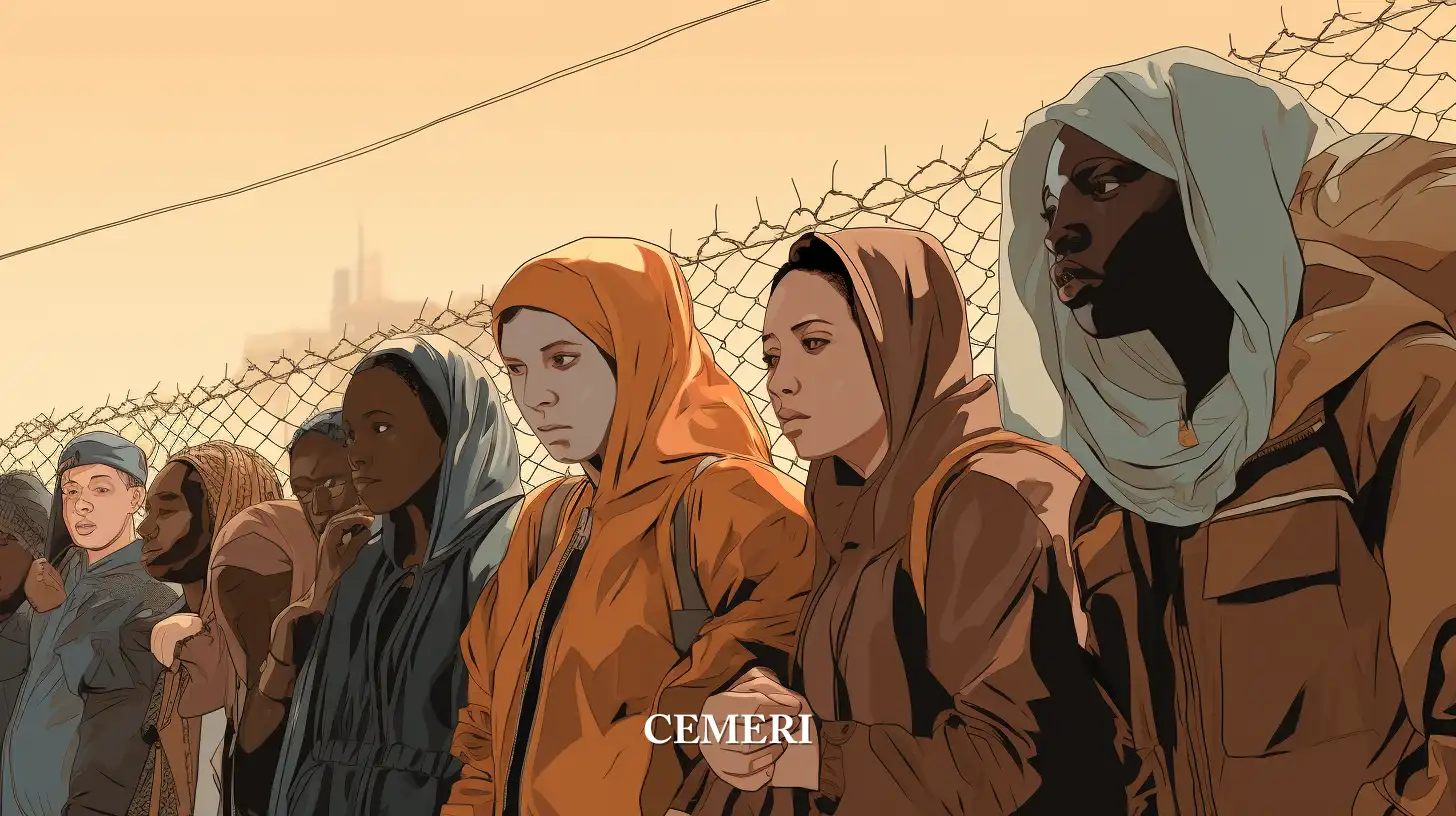Analysis
Oween Barranzuela
Türkiye's role in the Syrian refugee crisis
- In contrast to countries in the Middle East and the European Union, Turkey continued to assume the daunting task of receiving unimaginable numbers of refugees.

They say that a photo is worth a thousand words, a single photo is enough to activate our deepest feelings in us and discover realities that are foreign to our environment. 5 years ago the photo of little Aylan Kurdi's corpse shook the whole world; he was just three years old when instead of playing and enjoying his childhood in his native Syria, he met a tragic fate while escaping to Greece with his family in search of a new home. In a matter of hours, his photograph became a worldwide trend and opened the debate on the situation of Syrian migrants who, day after day, flee from the savage sound of war. His body was found on the Turkish coast facing the Aegean Sea; It is particularly this country that has hosted millions of Syrian migrants like Aylan during the last decade. Understanding the role of Turkey and its applied policies in the face of this humanitarian crisis is key to finding solutions to the challenge that refugees imply on the international agenda.
Let's start by stating the following: Turkey is no stranger to migration flows. Throughout its history, from the İttoman Empire to the formation of the republic in 1923, it has hosted people fleeing persecution in their countries of origin. Despite attempts in the West to portray Muslim nations as intolerant of other religions, the long-running Ottoman Empire was home to a multicultural society for more than 500 years. In times when the Holy Inquisition of Spain rigidly oppressed non-Catholics, Sultan Bayezid II opened the doors to Jewish refugees who were quickly established mainly in cities such as Istanbul, Izmir and Thessaloniki (in present-day Greece). His policy sought a cosmopolitan population, indeed the Ottoman government came to believe that a large population was the precondition for economic development as well as a strong defense against external enemies. (1) Another great migratory current occurred after the expansion of the Russians in the Crimean peninsula in the 19th century, giving rise to the great exodus of Muslim Tatars towards Anatolia.
As the Ottoman Empire began to lose significant territorial possessions, Bosnia became part of the Austro-Hungarian Empire and opened a phase of persecution against the Muslim population that had adopted an Ottoman culture and identity. Consequently, the persecuted leave for Turkey in 4 different migratory waves between 1878 and 1908. (2)
After the official formation of the Republic of Turkey, events on a global and regional scale caused the continuity of the migratory phenomenon. Such is the case of the Jews who escaped from the Nazi holocaust in Germany; Between 1933 and 1945 Jewish refugees, mostly scientists and academics, were legally admitted with their families to the newly formed republic. On the other hand, after the Iranian Revolution, according to official figures from the Turkish Ministry of the Interior, about a million people, mostly Kurds and Azerbaijanis, decided to flee towards central Anatolia. (3)
With these facts we can verify that migrations have been constant in the world due to human rights violations, genocide or wars and that Turkey has a long tradition of accepting huge movements of refugees. However, since World War II humanity has not seen a forced displacement as large as what is happening this century in Syria; Turkey is currently the country with the most refugees in the world, despite the great social and economic challenge it implies.
Turkey's role is largely attributed to its strategic geographical position. When the war in Syria slowly showed signs that it would be a long time coming to an end, millions of people had to choose between two directions: Lebanon and Turkey. The latter being the closest and safest option to escape. For example, Aleppo, one of the most populous cities in the entire country and the main theater of the war for a long time, is only 108 kilometers from the Turkish border. The first refugee victims of the war arrived in Hatay province in 2011.
Under the 'open door policy' Turkey initially received a small group of only 252 people, without the need for a visa or other requirement. For the Turkish authorities, the open door policy demonstrated that "even in the face of massive flows, it is possible to maintain a humanitarian approach and enact policies that prioritize the needs of refugees, rather than treating them as a threat to state security. ( 4)
At first it was believed that the internal conflict in Syria would cease and the temporary guests would return to their country of origin. However, the growing evolution in the numbers of Syrian migrants forced a mandatory change in immigration laws to deal with the crisis that directly affected Turkey's borders and that was beginning to have social havoc in different cities in the interior of the country. In 2013, the Turkish Parliament unanimously approved the Law on Aliens and International Protection in order to optimize the legal framework for refugees. Through this law, the protection of the rights of civilians seeking refuge was guaranteed, providing them with services and a guarantee of temporary protection status.
In contrast to countries in the Middle East and the European Union, Turkey continued to assume the daunting task of receiving unimaginable numbers of refugees. The initial period was characterized by managing the crisis through refugee camps where it was possible to accommodate and provide basic services to the population fleeing the Syrian regime. However, between 2014-2016 the capacity of these places was exceeded by the significant arrival of refugees and the increase in the rate of Syrian babies born in Turkish territory, thus causing their distribution to other provinces. (5) It should be noted that currently the camps called "Temporary Refuge Centers" house 59,645 Syrians in cities such as Hatay, Osmaniye, Adana, Kilis and Kahramanmaraş.
Source: Distribution of Syrian refugees in the scope of temporary protection by year until November 2020, General Directorate of Migration Management of the Ministry of the Interior of Turkey.
Since the crisis in Syria began in 2011 to date, according to the United Nations High Commissioner for Refugees (UNHCR), Turkey hosts more than 3.6 million Syrian refugees, added to this is followed by Afghans (164,351), Iraqis (142,576), Iranians (37,732), Somalis (5,518) (11) which have made Turkey the main host country for refugees.
Turkey's use of resources to address the humanitarian crisis Lamentations for the humanitarian crisis in Syria by the international community were only in words, but not in actions. The financial support of the United Nations has been limited to 3,290 million dollars and the European Union has financed 3,300 million dollars through its respective NGOs. These figures are in stark contrast to Turkey's funding for refugees, not to mention Turkey has its own domestic economic problems, yet it has spent $40 billion over the last 9 years using Turkish public funds. This is a reflection of the inefficient response and lack of humanitarian responsibility on the part of the West in the face of the crisis.
According to the Global Humanitarian Assistance report prepared in 2020, Turkey is ahead of the United States and Germany with spending that represents 0.84% of its GDP in 2019. In this way, it becomes the country that has most provided humanitarian aid for the third consecutive year.
Source: Global Humanitarian Assistance Report, 2020
Dans le cadre de la "politique de la porte ouverte", la Turquie a initialement reçu un petit groupe de seulement 252 personnes, sans avoir besoin d'un visa ou d'une autre exigence. Pour les autorités turques, la politique de la porte ouverte a démontré que « même face à des flux massifs, il est possible de maintenir une approche humanitaire et d'adopter des politiques qui donnent la priorité aux besoins des réfugiés, plutôt que de les traiter comme une menace pour la sécurité de l'État. ( 4)
Au début, on croyait que le conflit interne en Syrie cesserait et que les invités temporaires retourneraient dans leur pays d'origine. Cependant, l'évolution croissante du nombre de migrants syriens a forcé une modification obligatoire des lois sur l'immigration pour faire face à la crise qui touchait directement les frontières de la Turquie et qui commençait à faire des ravages sociaux dans différentes villes de l'intérieur du pays. En 2013, le Parlement turc a approuvé à l'unanimité la loi sur les étrangers et la protection internationale afin d'optimiser le cadre juridique pour les réfugiés. Grâce à cette loi, la protection des droits des civils cherchant refuge a été garantie, en leur fournissant des services et une garantie de statut de protection temporaire.
Contrairement aux pays du Moyen-Orient et de l'Union européenne, la Turquie a continué d'assumer la lourde tâche d'accueillir un nombre inimaginable de réfugiés. La période initiale a été caractérisée par la gestion de la crise à travers des camps de réfugiés où il a été possible d'héberger et de fournir des services de base à la population fuyant le régime syrien. Cependant, entre 2014-2016, la capacité de ces lieux a été dépassée par l'arrivée importante de réfugiés et l'augmentation du taux de bébés syriens nés sur le territoire turc, provoquant ainsi leur répartition dans d'autres provinces. (5) Il convient de noter qu'actuellement, les camps appelés "centres de réfugiés temporaires" abritent 59 645 Syriens dans des villes telles que Hatay, Osmaniye, Adana, Kilis et Kahramanmaraş.
Source : Répartition des réfugiés syriens dans le cadre de la protection temporaire par année jusqu'en novembre 2020, Direction générale de la gestion des migrations du ministère de l'Intérieur de Turquie.
Depuis le début de la crise en Syrie en 2011 à ce jour, selon le Haut Commissariat des Nations unies pour les réfugiés (HCR), la Turquie accueille plus de 3,6 millions de réfugiés syriens, auxquels s'ajoutent les Afghans (164 351), les Irakiens (142 576), les Iraniens (37 732), des Somaliens (5 518) (11) qui ont fait de la Turquie le principal pays d'accueil des réfugiés.
Utilisation des ressources par la Turquie pour faire face à la crise humanitaire Les lamentations sur la crise humanitaire en Syrie par la communauté internationale n'ont été exprimées qu'en paroles, mais pas en actes. Le soutien financier des Nations Unies a été limité à 3 290 millions de dollars et l'Union européenne a financé 3 300 millions de dollars à travers ses ONG respectives. Ces chiffres contrastent fortement avec le financement de la Turquie pour les réfugiés, sans oublier que la Turquie a ses propres problèmes économiques intérieurs, mais qu'elle a dépensé 40 milliards de dollars au cours des 9 dernières années en utilisant des fonds publics turcs. Cela reflète la réponse inefficace et le manque de responsabilité humanitaire de la part de l'Occident face à la crise.
Selon le rapport Global Humanitarian Assistance préparé en 2020, la Turquie devance les États-Unis et l'Allemagne avec des dépenses qui représentent 0,84% de son PIB en 2019. Elle devient ainsi le pays qui a le plus apporté une aide humanitaire aux troisième année consécutive.
Source : Rapport mondial sur l'aide humanitaire, 2020
A significant percentage of the money is earmarked for the education of the Syrian population in Turkey. During the 2019-2020 school year, more than 684,000 girls and boys attended schools across the country. The highest schooling rate is found among primary school students with 90% (6), during the initial stage teaching in their native language is prioritized, as well as Turkish language learning programs to facilitate their progress and allow them to integrate in society.
The Integration Challenge
To date, refugees are found in all 81 provinces throughout Turkey. In Istanbul there are more than half a million legally registered Syrians, followed by Gaziantep and Şanliurfa. Kilis province is a special and interesting case that should attract a lot of attention. It has 142,490 inhabitants of which 108,657 are Syrian. That is, the number of refugees has exceeded that of local residents, the Syrian population represents 76.26% of its total population.
Source: Distribution of Syrians under temporary protection in the 10 main provinces as of November 2020, General Directorate of Migration Management of the Ministry of the Interior of Turkey.
Due to the intensification of the Syrian civil war, the possibilities of return have been diminishing year after year, some have chosen to use Turkey as a bridge to reach Europe in search of new jobs, others have continued to seek opportunities that allow them greater independence and economic integration. According to the Turkish Ministry of Commerce until 2019 Syrians created, or were partners in the creation of 159.59 companies thus opening jobs that benefit locals and Syrians. However, factors such as the recurring informal work and the inflation caused by the high demand for basic foods with the arrival of the refugees have created great discontent within Turkish society. Turkish people claim that Syrians agree to work without insurance and for minimum wages, therefore employers find it better to employ cheap labor. For this reason many Turkish citizens have lost their jobs. (7)
Poster promoting an Aleppo food restaurant in Konya, Türkiye. In urban areas with a higher concentration of Syrians, this type of advertising in Arabic aimed at the Syrian public can be found. Photo taken by the author.
Faced with state spending, the population has made their discomfort felt as they fear that the economy will worsen, they also demand a greater prioritization of the affairs of their own population. Added to this, the growing number of Syrians who have obtained Turkish citizenship has fueled anger and antipathy against them. Interior Minister Süleyman Soylu stated in 2019 that 110,000 Syrians had been granted citizenship, of whom 57,000 were children. (8)
This wave of negative perceptions is deteriorating social relations between Turks and Syrians, creating a debate about their continuity in the country. The tensions have reached social networks where campaigns have been created against Syrian refugees questioning state aid. Despite the fact that Syrians and Turks are mostly Muslim, cultural and social differences, and mainly language barriers, have made the integration process difficult: When we see other migratory flows in the world, that of Venezuelans migrating to Colombia or Peru stands out, countries where they speak a same language which greatly facilitates the interaction with the locals.
The return of peace to Damascus is a long way off, and Turkey is the one that will continue to suffer collateral damage due to its location. The humanitarian crisis that began in 2011 could have represented an opportunity for global cooperation, however, it was the opposite. The countries that mourn the deaths of thousands of refugees every year in the Mediterranean continue to fail to fulfill their humanitarian responsibility and hide behind Islamophobic discourse.
Turkey opened its doors to more refugees than all the 27 member states of the European Union, its response has been swift, but with many risks to its economy and national security. With close to 4 million Syrians registered to date, the challenge is great and the ability to manage this crisis inside the country, as well as its military interventions in Syria will be decisive for the stability that is so desired in this part of the country. world. Turkey and the European Union must put aside their differences and strengthen their alliances and diplomatic relations, since the future of Syrian refugees depends on them.
Sources
[1] Kemal H. Karpat, Ottoman Population 1830-1914: Demographic and Social Characteristics, London. The University of Wisconsin Press, 1985, p. 62.
[2] Ilgın Barut, Efectos de las migraciones sobre las políticas de institucionalización y migración en el período otomano ( Osmanli dönemi’nde gerçekleşen göçlerin kurumsallaşma ve Göç politikalari üzerindeki etkileri ), Revista de estudios de política social, Núm.40/2 (octubre 2018).
[3] Dirección general de gestión migratoria, Kitlesel Akımlar, https://www.goc.gov.tr/kitlesel-akinlar, consultada el 13 de noviembre del 2020.
[4] The Syrian refugee challenge and Turkey’s quest for normative power in the Middle East, Özden Zeynep Oktav, Aycan Çelikaksoy . 2015, Vol. 70(3).
[5] Refugiados sirios en Turquía (TÜRKİYE’DEKİ suriyeli mülteciler), Prof. Dr. M. Murat Erdoğan, Centro de Estudios de Migración e Integración de la Universidad Turco-Alemana, septiembre 2019.
[6] https://www.dailysabah.com/turkey/education/turkey-sets-an-example-in-schooling-rate-of syrianrefugees#:~:text=The%20schooling%20rate%20of%20Syrian,attended%20schools%20across%20the%20country , consultada el 14 de noviembre del 2020.
[7] La gobernanza de la migración y los efectos de los refugiados sirios en la economía y la vida social turcas (Türkiye’de Göç Yönetişimi Ve Suriyeli Sığınmacıların Türkiye’ye Ekonomik Ve Sosyal Etkileri), Doğu Safa Arık, Universidad, Revista Universitaria del Instituto de Ciencias Sociales, Universidad Adnan Menderes, Vol. 7, año 2020.
[8]https://www.a3haber.com/2019/12/30/icisleri-bakani-soylu-istanbulda-474-bin-suriyeli-var-110-bin-suriyeliye-vatandaslik-verdik/ , consultada el 10 de noviembre del 2020.

